Key Points:
- Barn-funnel weavers create funnel shaped webs to trap their prey. They are rarely aggressive toward humans.
- Male tiger wolf spiders can be 25 millimeters long. Instead of using a web for entrapment, they will chase down their prey and kill with a bite.
- Hammock spiders are quite small, with adults being only 3.6 to 7 millimeters long. They weave hammock-shaped webs to catch prey and pose no threat to humans.
Ohio is also known as The Buckeye State. This name is a nod to the fact that the state was once covered in buckeye trees. The state’s nickname is a celebration of its natural heritage, a heritage that continues to this day. After all, many plants and animals continue to make their homes in the state, such as spotted salamanders and white-tailed deer. Ohio is also home to many interesting species of spiders. From giant huntsman spiders to tiny jumping spiders, you can find a range of spiders in Ohio. Here is a list of 10 spiders in Ohio that make their homes in The Buckeye State.

#10. Mediterranean Recluse

The Mediterranean recluse is a highly invasive species.
©Malpolon/Shutterstock.com
The Mediterranean recluse, Loxosceles rufescens, belongs to the Sicariidae family. While originally from the Mediterranean, you can now find it throughout much of the world. As such, it is simultaneously one of the most venomous and invasive spiders in Ohio.
Both female and male Mediterranean recluses measure around 7 to 7.5 millimeters long. Additionally, both sexes appear primarily light or dark brown. Like other recluse spiders, they feature a violin-shaped marking on the cephalothorax and 6 rather than 8 eyes. At first glance, they are almost entirely indistinguishable from brown recluse spiders, Loxosceles reclusa.
Mediterranean recluses dwell in caves and other dry, dark environments. At night, they emerge from their webs to actively hunt prey. Their bite can cause a range of symptoms including pain, redness, swelling, and skin necrosis. On rare occasions, their bite may also rupture blood cells, cause blood clots, or lead to renal failure.
#9. European Garden Spider

European garden spiders construct orb webs that they use to capture prey.
©novama/Shutterstock.com
The European garden spider, Araneus diadematus, belongs to the orb weaver family Araneidae. It goes by many other names including the diadem spider, crowned orb weaver, and cross spider. Originally hailing from Europe, you can now find these spiders in Ohio and throughout much of North America.
Adult females measure between 6.5 and 20 millimeters long and males measure from 5.5 to 13 millimeters long. They range in color from light-yellow to dark-grey. That said, all European garden spiders feature mottled white markings on the abdomen. Additionally, the abdomen always contains four intersecting lines that form a cross.
European garden spiders construct orb webs that they use to capture prey. Once prey gets entangled in their webs they move in to bite and wrap up their food for later consumption. Occasionally, females will also cannibalize males. While venomous, their bite is not medically significant.
#8. Barn Funnel Weaver
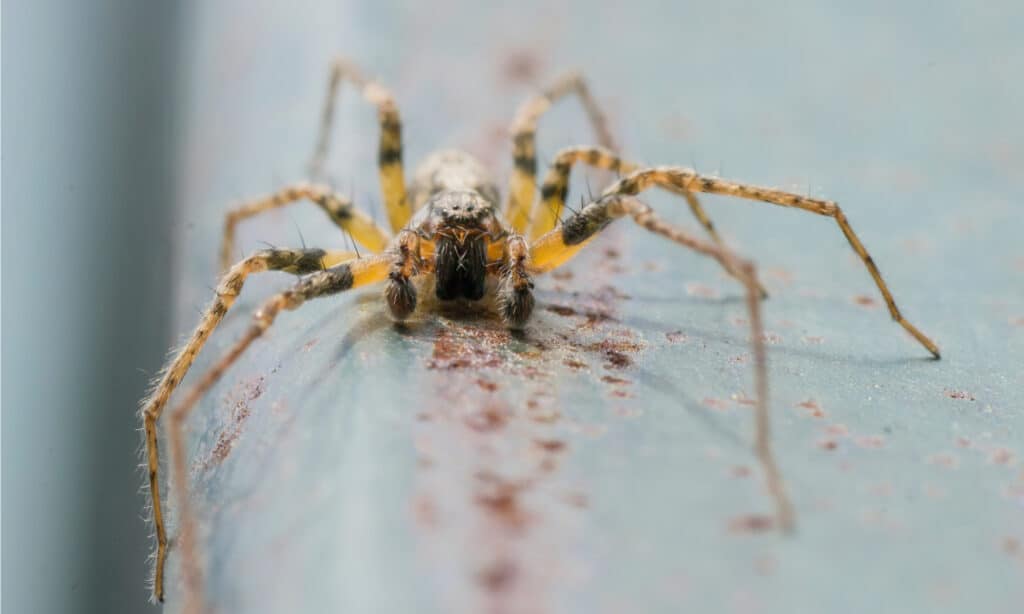
The barn funnel weaver builds a funnel-shaped web that it uses to capture prey.
©Korovko Gleb/Shutterstock.com
Tegenaria domestica, or the barn funnel weaver, is a member of the family Agelenidae, or funnel weavers. In Europe, it goes by the name the domestic house spider. It is one of the most common funnel weaver spiders in Ohio and throughout much of the world.
Female barn funnel weavers range between 7.5 and 11.5 millimeters long while males measure 6 to 9 millimeters long. The cephalothorax appears quite flat while the abdomen looks more straight than bulbous. Their legs and bodies are relatively proportional to one another, unlike many other species of spiders. They appear primarily dark orange, beige, or brown, and feature dull black stripes through the center of the cephalothorax and dark markings on the abdomen.
Barn funnel weavers construct funnel-shaped webs that they use to capture prey. They rarely act aggressively towards humans, and typically flee from light.
#7. Striped Fishing Spider
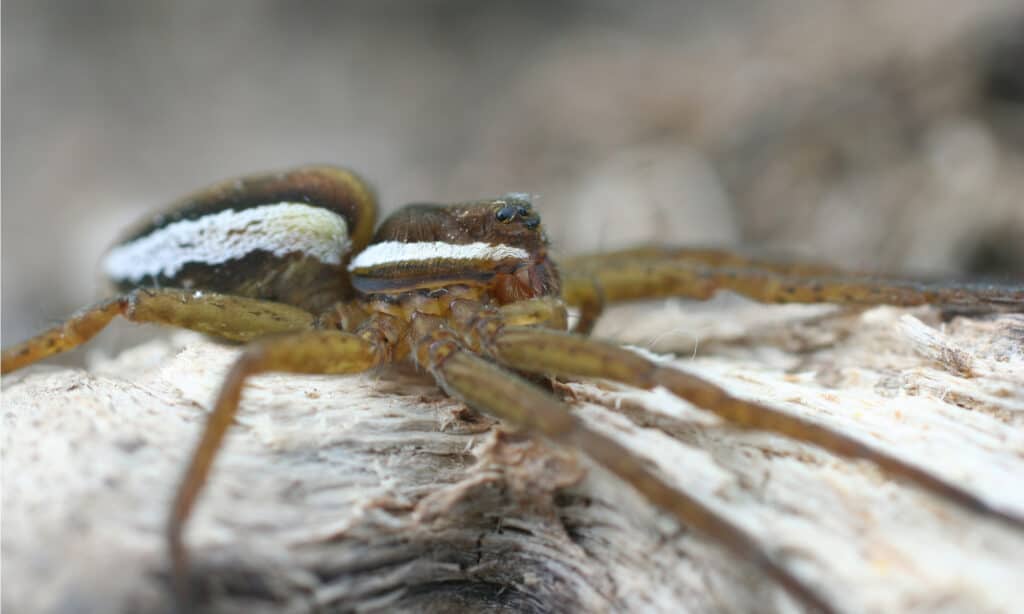
The striped fishing spider hunts for food near or in the water.
©Oleg Nikonov/Shutterstock.com
Dolomedes scriptus is more commonly known as the striped fishing spider. It belongs to the fishing spider family Pisauridae. You can find these spiders in Ohio as well as throughout much of the United States and Canada.
Adult females can grow up to 2.5 centimeters long. Meanwhile, males measure noticeably smaller than females. They generally appear primarily light brown but can range in color from tan to grey. A thick white or tan stripe runs down both sides of the body and they feature dark W-shaped markings on the abdomen.
Striped fishing spiders are semi-aquatic, which means they tend to live along streams, ponds, lakes, or other bodies of water. They don’t use webs to catch prey, instead relying on their speed and stealth. Their preferred methods include using their legs as fishing lures, running across the water’s surface, or diving into the water to catch prey.
#6. Tiger Wolf Spider
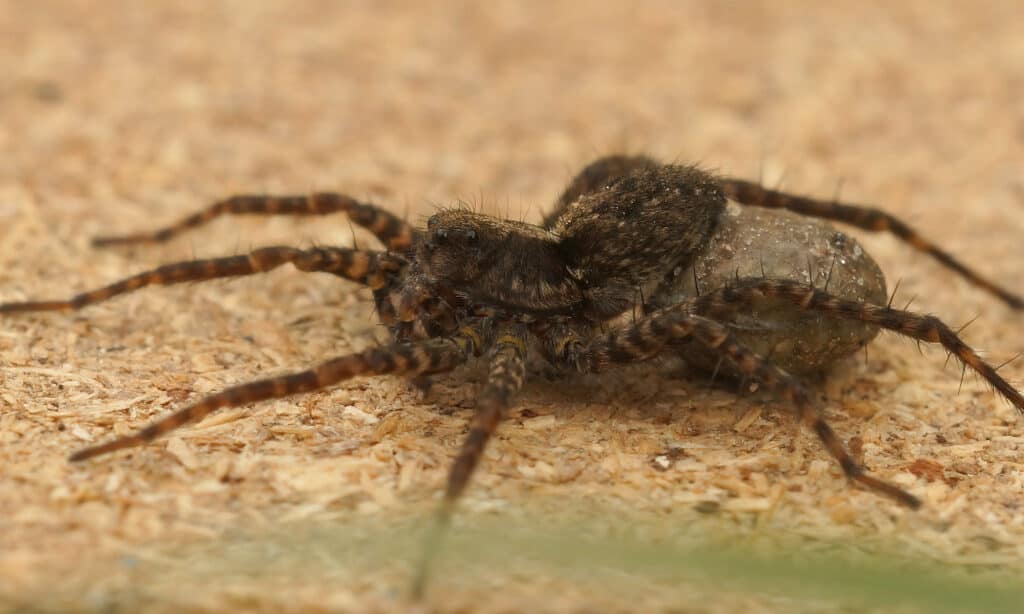
The
tiger
wolf spider is also known as the speckled wolf spider or woodland giant wolf spider
©HWall/Shutterstock.com
The tiger wolf spider, Tigrosa aspersa, belongs to the wolf spider family Lycosidae. You may know it by other names including the speckled wolf spider or woodland giant wolf spider. It is widely distributed throughout much of the eastern United States.
Adult specimens can reach up to 25 millimeters long, although males typically measure smaller than females. They feature a distinctive narrow yellow line in the space between the eyes. Females look primarily black except for the abdomen which looks more dark grey. On the other hand, males come in a range of colors from beige to tan to light yellow. During the mating season, you’ll often see females carrying their eggs on top of their spinnerets.
Tiger wolf spiders do not use webs to capture their prey. Instead, they are active hunters that rely on their speed and power to chase down insects. Their bite is not medically significant.
#5. Garden Ghost Spider
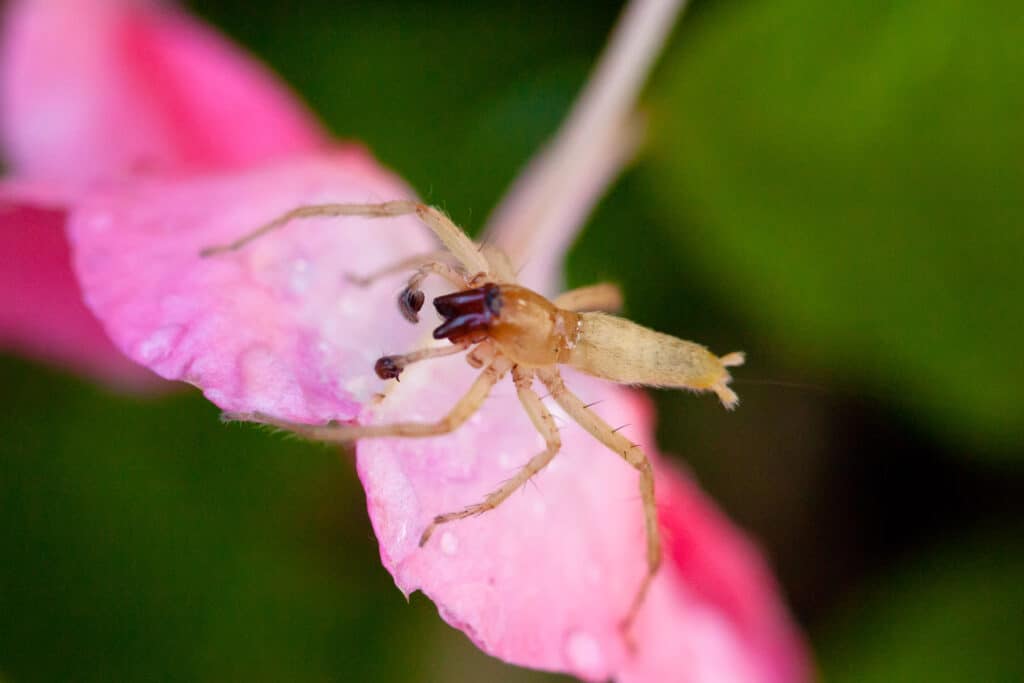
The garden ghost spider’s translucent yellowish-green body appears practically ghost-like
©Melissa McMasters / flickr – License
Hibana gracilis, or the garden ghost spider, belongs to the ghost spider family Anyphaenidae. You can find these curious little spiders in Ohio along with much of the eastern United States and areas of Canada.
Adult garden ghost spiders usually measure from 6 to 12 millimeters long, with males measuring smaller than females. They often get mistaken for yellow sac spiders due to their similar shape, as both possess a long, thin abdomen and elongated spinneret. Most specimens appear yellowish-green and feature dark markings on the abdomen. That said, they look practically translucent, hence their name.
During the day, garden ghost spiders hide in silken retreats. However, they do not use their webs to catch prey, as they emerge at night to actively hunt for food. While their bite can cause some minor pain, redness, or swelling, it’s not otherwise medically significant.
#4. Black Lace Weaver
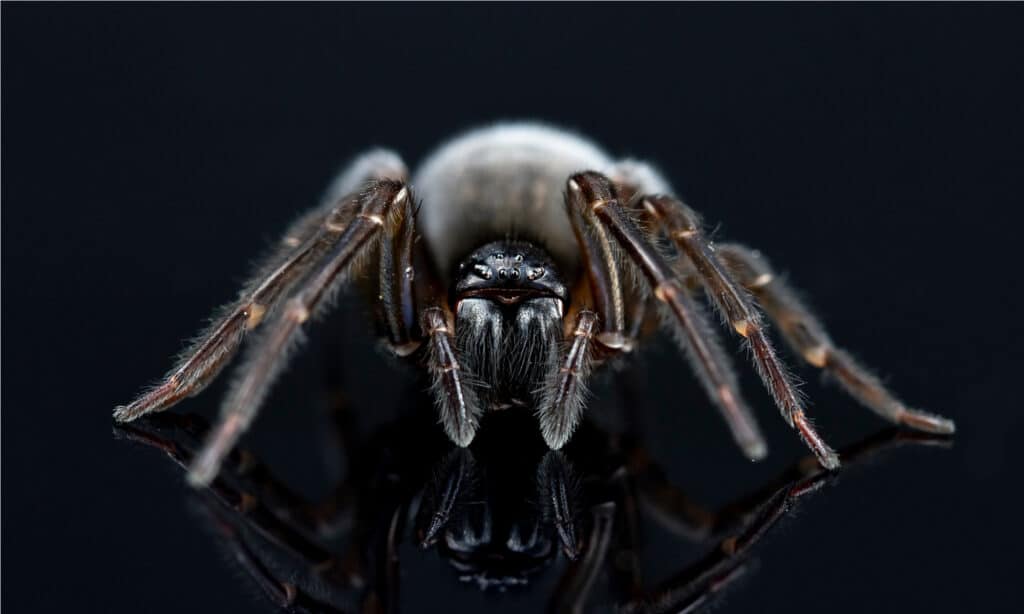
The black lace weaver’s web has a wooly texture that makes it appear lace-like.
©IanJHall/Shutterstock.com
The black lace weaver, Amaurobius ferox, is a member of the three-clawed cribellate spider family Amaurobiidae. While originally native to Europe, you can now find these spiders in Ohio as well as throughout the United States and New Zealand.
Female black lace weavers measure between 11 and 16 millimeters long while males measure 8 to 10 millimeters long. They usually appear predominantly black but can range in color from dark brown or red. However, they often feature a pale yellow marking in the shape of a skull on top of the abdomen.
You can often find black lace weavers in dark, damp places such as under stones or cracks in walls. They build cribellate webs made of thin, sticky threads with a wooly texture. Due to this texture, their webs appear practically lace-like, hence their name. Their bite is not medically significant.
#3. Huntsman Spider
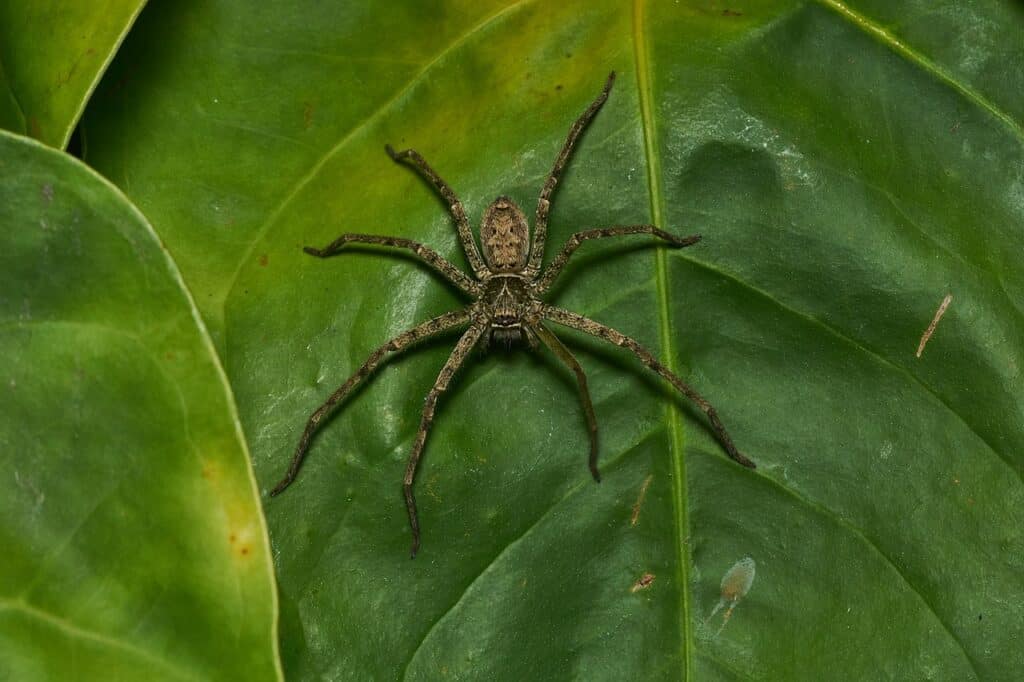
Pantropical huntsman spiders can measure nearly 12 centimeters long with their legs extended
©© 2017 Jee & Rani Nature Photography / CC BY-SA 4.0 via Wikimedia Commons – License
Heteropoda venatoria goes by many other names including the cane spider and giant crab spider. That said, since it belongs to the family Sparassidae most people simply refer to it as the pantropical huntsman spider. It lives in subtropical regions throughout the world and also happens to be one of the largest spiders in Ohio.
Adult pantropical huntsman spiders measure 20 to 25 millimeters long, with females measuring slightly larger than males. However, males generally possess longer legs than females. They appear primarily light brown or tan with dull black markings. The space in front of the eyes looks cream or yellow and they feature a creamish-tan band in the center of the carapace.
Pantropical huntsman spiders actively chase down and overpower their prey. They will even attack and eat larger animals, including scorpions and bats. While their bite is not dangerous to humans it can be painful.
#2. Tan Jumping Spider
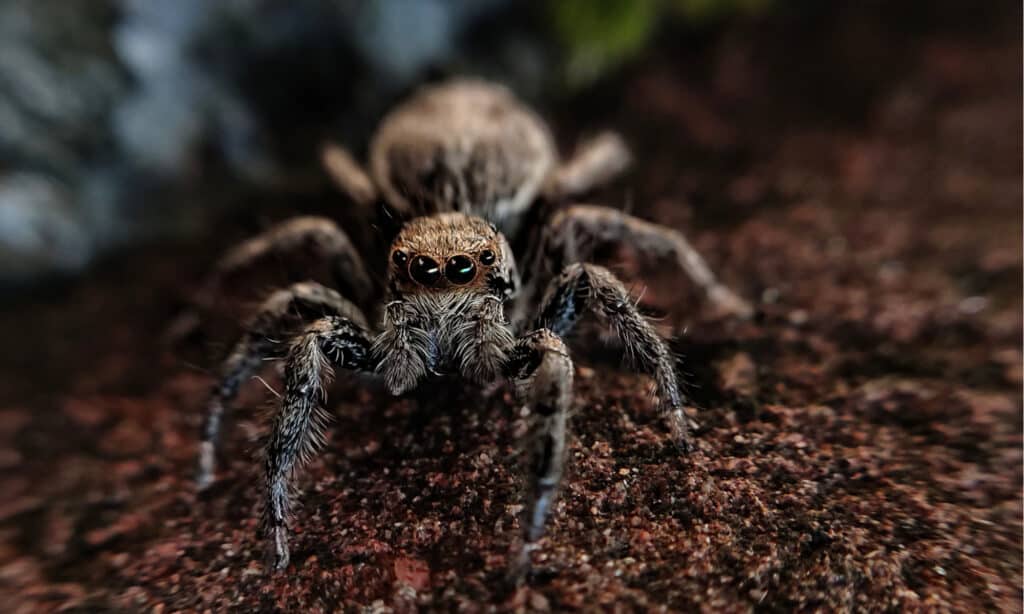
Tan jumping spider close up shot showing round eyes and furry body
©SwastikEs/Shutterstock.com
The tan jumping spider, Platycryptus undatus, belongs to the jumping spider family Salticidae. It is one of several jumping spiders in Ohio and ranges throughout much of North America.
Adult females range between 10 and 13 millimeters long, and males measure from 8.5 to 9.5 millimeters long. They appear predominantly grey, brown, or tan, hence their name. The abdomen features distinctive V-shaped markings down its entire length which appear either beige or grey.
Like other members of its family, the tan jumping spider does not build webs to catch its prey. On the contrary, it actively hunts its prey using its keen eyesight and jumping ability. It will leap onto its prey from a great distance but also relies on its jumping skills to escape larger predators. While it may bite humans if threatened, its bite is not medically significant.
#1. Hammock Spider

The hammock spider builds a hammock-shaped web that it uses to catch prey.
©Moni.ka/Shutterstock.com
Pityohyphantes costatus, or the hammock spider, belongs to the sheetweb spider family Linyphiidae. You can find these tiny spiders in Ohio as well as throughout parts of the United States.
Adult hammock spiders measure 3.6 to 7 millimeters long, with females measuring larger on average than males. The carapace and legs appear predominantly light beige or grey-brown. That said, a dark brown or black line runs down the center of the carapace. Meanwhile, the abdomen looks light bright with a dark brown patch down the middle and white spots on the sides.
Hammock spiders build hammock-shaped webs that they use to capture prey, hence their name. They make their webs in shrubs or on tree branches and wait near the edge of the web or on nearby leaves for prey to stumble inside their silk hammock. Due to their small size, they pose no significant threat to humans.
Summary of Spiders in Ohio
| Rank | Spider | Scientific Name |
|---|---|---|
| 1 | Hammock Spider | Pityohyphantes costatus |
| 2 | Tan Jumping Spider | Platycryptus undatus |
| 3 | Huntsman Spider | Heteropoda venatoria |
| 4 | Black Lace Weaver | Amaurobius ferox |
| 5 | Garden Ghost Spider | Hibana gracilis |
| 6 | Tiger Wolf Spider | Tigrosa aspersa |
| 7 | Striped Fishing Spider | Dolomedes scriptus |
| 8 | Barn Funnel Weaver | Tegenaria domestica |
| 9 | European Garden Spider | Araneus diadematus |
| 10 | Mediterranean Recluse | Loxosceles rufescens |
The photo featured at the top of this post is © SwastikEs/Shutterstock.com
Thank you for reading! Have some feedback for us? Contact the AZ Animals editorial team.






